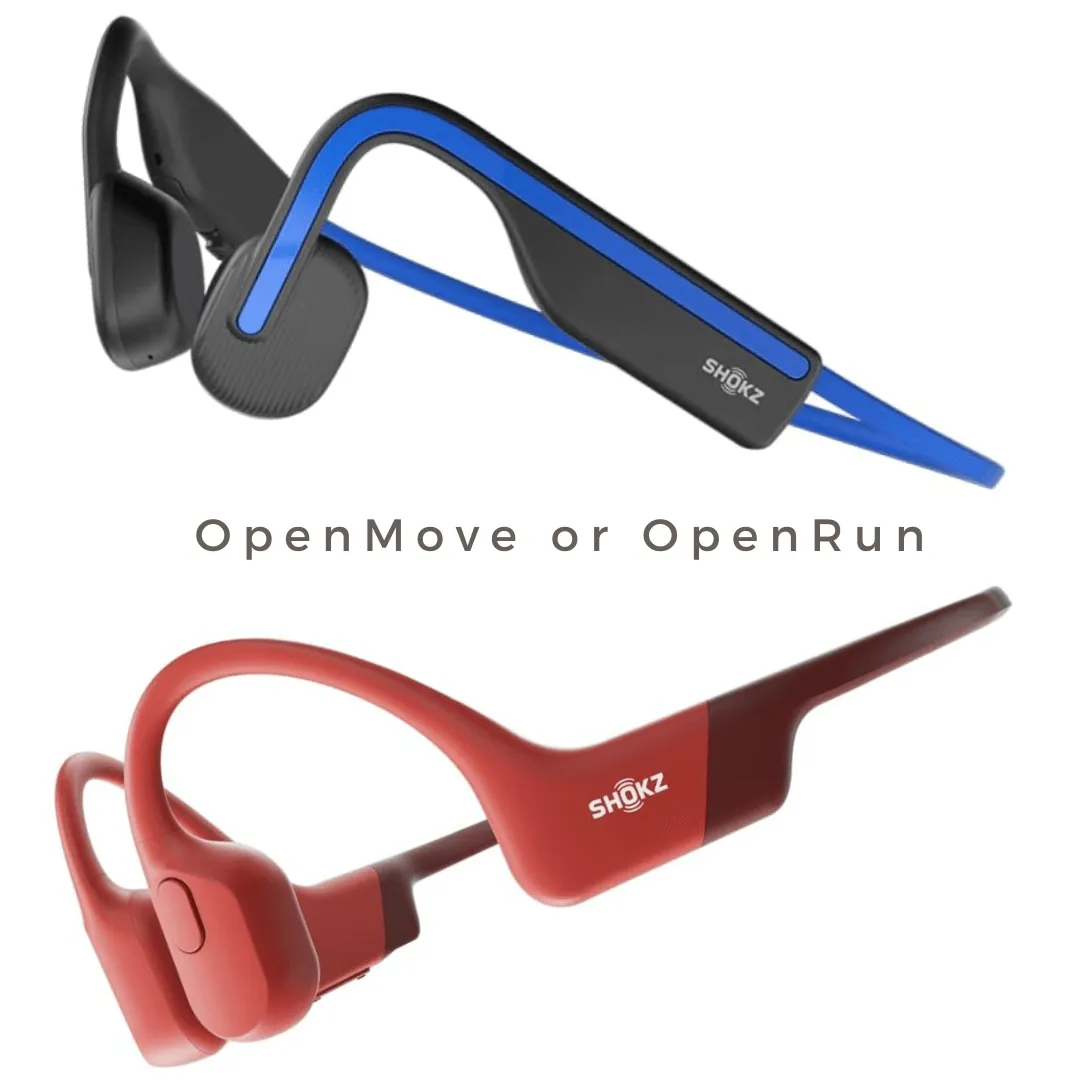Shokz is arguably the leading brand when it comes to open-ear bone conduction headphones. The company brought the technology into the mainstream for commercial use, and it’s still leading the market with technical improvements. OpenRun is probably Shokz’s most popular model, but OpenMove is often recommended as an alternative. So, which is best, and what is the difference?
OpenMove is a budget-friendly version of OpenRun. Its manufacturing quality is slightly lower, it has a slightly less comfortable fit, and its battery life isn’t as good as the OpenRun’s. OpenMove is also less water resistant. Sound quality differs a bit, with OpenRun having a slight advantage.
Shokz managed to offer a high-quality set of bone conduction headphones at a significantly lower price with OpenMove without affecting the user experience too much. However, some users still prefer OpenRun over OpenMove. Let’s compare the two more closely so you can see which one will suit you best.

OpenMove Vs. OpenRun
On a technical level, there are very few differences between Shokz’s budget model, OpenMove, and its former flagship, OpenRun (dethroned by OpenRun Pro). Still, the few differences will make one of them a better fit for some people.
Connectivity
OpenRun and OpenMove both use Bluetooth 5.1 with multipoint connectivity, allowing you to pair them with two separate devices simultaneously. They offer similar performance, though I found that OpenMove has a slightly shorter range. It’s not so significant that it will affect you much, but I can move a few steps further away from my phone while wearing OpenRun than with OpenMove.
Sound Quality
Sound quality is a sensitive topic when it comes to bone conduction. Though Shokz has made incredible improvements in the field, it’s crucial to remember that bone conduction headphones cannot deliver the same audio quality you get from air conduction models. OpenRun and OpenMove aren’t exceptions to the rule.
OpenMove comes with Shokz’s PremiumPitch 2.0 technology, which delivers sound quality that’s better than what you’d expect from typical bone conduction headphones. However, it has a limited dynamic range, and the bass is fairly weak, still it’s quite good for bone conduction. Users that listen to podcasts rather than music will find it perfectly adequate.
OpenRun supports PremiumPitch 2.0+, which is an enhanced version with far better bass response. It sounds equally crisp, but the bass is much more well-defined, creating a more immersive sound experience.
Though neither model is suitable for audiophiles, the OpenMove is better for causal listening, and the OpenRun is better for those who want better audio quality from their bone conduction headphones. It’s still not the best out there, but it is better than the OpenMove.
Battery Life And Charging
OpenRun’s battery lasts approximately 8 hours, depending on your listening volume. Bone conduction headphones are notorious for their low-volume issues because they don’t cover or plug your ears, so it’s challenging to keep them at a sane volume, which might eat into your battery life much faster.
OpenMove’s battery is rated to last about 6 hours, which is considerably less, so it’s not as ideal for all-day listening as OpenRun.
OpenRun uses a magnetic charger capable of quick charging; you can charge it to 100% within an hour and a half, and 10 minutes of charging will give you an hour and a half of listening time.
OpenMove uses a standard USB-C charger. It isn’t capable of quick charging, so it will take about 2 hours to charge it to 100%. This doesn’t seem like much of a difference until you take the shorter battery life into account, but it isn’t terrible, either.
So, people who want to use their headphones most of the day with only limited breaks for charging will be better off with OpenRun, but purely for occasional listening while running or driving, the cheaper OpenMove will suffice.
Water- And Dust Resistance
Shokz’s OpenRun has a near-perfect water- and dust resistance rating of IP67. It is perfectly water-resistant, though not 100% waterproof. You can safely wear OpenRun when you’re sweating profusely or running in adverse weather conditions. Some people even wear it in the shower. But it’s not safe to wear while you’re swimming.
OpenMove has a lower rating of IP55. It is water resistant but far from waterproof. You can wear them when sweating or in a bit of rain, but nothing more than that.
If you know that rain and sweat will be a significant problem, don’t opt for OpenMove. It might perform perfectly well, but it’s better to be safe and buy OpenRun.
Comfort
Both headphones are very comfortable. The open-ear technology helps with that since you won’t get ear fatigue from something plugging your ears for hours on end.
They both fit comfortably around your neck and over your ears. Their designs even ensure that you can wear glasses or sunglasses while wearing your headphones with little to no added pressure.
Of the two, OpenRun has a slight comfort advantage. Firstly, it weighs 0.9 ounces (26 grams) compared to OpenMove’s 1 ounce (29 grams). Though that difference is so slight that it almost isn’t worth mentioning, it can still make a difference when you’re wearing the headphones for a few hours at a time.
The second advantage is that the manufacturers didn’t make any sacrifices in its design quality like they did with OpenMove. OpenRun’s frame is full of titanium and perfectly balanced to create an excellent fit.
That’s not the case with OpenMove. Its headband contains titanium, but it has Polycarbon ear hooks that cause slightly uneven weight distribution, leading to a less comfortable fit. This doesn’t make OpenMove particularly uncomfortable, but OpenRun has a definite advantage that you can feel the moment you put it on.
Price And Value
Prices for both headphones differ substantially, depending on where (and when) you buy them, but OpenMove is considerably more affordable. You can get OpenRun for approximately $130, while OpenMove retails for around $80.
You can feel why OpenMove is cheaper when you hold it. It feels less premium than OpenRun, but it’s understandable since it’s a budget model with features nearly identical to OpenRun.
Both come with their respective chargers, user manuals, and carrying bags included in the box, but OpenRun also includes a Shokz headband, so there’s a little bit of added value there.
User Experience
Despite how similar the two devices are, you start to notice the differences when you use both. I’ve been using my OpenRun for a while now, mainly while running, so I’m used to its fit and the reduced sound quality.
Getting used to OpenMove was a bit of a challenge. The difference in build quality is immediately noticeable, and it never seemed to fit quite as comfortably as my OpenRun. It wasn’t uncomfortable, but I noticed the difference, especially over my ears.
Even though the sound quality shouldn’t make a significant difference, it was still tangible. OpenMove’s sound wasn’t as full and dynamic as OpenRun’s, especially on songs with prominent bass. This was a bit of a letdown, but I have to mention that none of this would have bothered me if I wasn’t already used to the OpenRun.
Conclusion
OpenRun is the de facto standard in bone conduction headphones, and Shokz is constantly improving its design and technology to make it even better. OpenMove is a fantastic budget model that almost matches OpenRun in many ways, but Shokz sacrificed a few factors to make it more affordable.
Casual listeners who will only use their headphones for a few hours a day and won’t exercise in adverse weather conditions can save a few dollars and buy OpenMove. Anyone who’s concerned about sound quality, better water resistance, and longer battery life will do well by paying a little bit extra for OpenRun.

